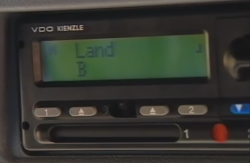Pros and Cons of 2017 Digital Logbook Trucking Regulation
Truck Drivers Required to Electronically Log Hours Beginning in 2017
In 1938, the federal government passed legislation that requires truck drivers to log their hours in order to limit the total amount of continuous time they spend on the road. These paper ledgers, in theory, are supposed to increase public safety by reducing the number of exhausted truck drivers on public highways.
However, these mileage logs can be easily manipulated, or in some cases an alternate set of records can be kept in order to cheat the system. In an attempt to crack down on this, beginning in 2017, the government now requires that all commercial trucks and busses electronically record driver hours using a digital tachograph. The new regulations take effect in the beginning of 2017.
How does a Tachograph Work?
A tachograph is an electronic device that automatically records a vehicle’s speed and total distance travelled.

Learn a brief history and overview of the adoption of mandatory digital tachograph legislation in the UK. Watch -->
They were originally used by the railroad companies in order to spot any peculiar irregularities with their commercial trains. Many logistics employers currently choose to use tachographs, however they are not legally mandatory. The device itself is attached to the engine block, and measures the total amount of engine activity. This makes them incredibly hard to manipulate, and are considered by many logistics specialists to be a much more foolproof alternative to paper logs.
Information is typically stored on a tachograph chart, and can be read by whoever is performing the audit. Digital data can be stored for a 12 month period, so companies and federal officials have a constant log of the driver’s performance. Tachographs have been mandatory for commercial drivers in Europe since 2006, though the effectiveness of the regulation has been disputed.
Truck Driver Log Book Rules in the United States
Log book hours are established and regulated by the Federal Motor Carrier Safety Administration (FMCSA). These rules apply to any CMV vehicle, which is defined as:
- Exceeding 10,001 pounds
- Can transport 16 or more passengers (not for compensation)
- Can transport 9 or more passengers (for compensation)
- Is designed for transporting hazardous materials
Rules vary for both passenger and non-passenger commercial vehicles. But some of the fundamental guidelines include:
Non Passenger
- Can drive 11 consecutive hours after a 10 hour period off
- May not drive past the 14th hour after clocking in
- May drive only if 8 hours or less have passed since the end of the driver's last off-duty sleeper berth period of at least 30 minutes
Passenger Carrying Vehicles
- Can drive 10 consecutive hours after 8 hours off
- May not drive past the 15th hour after clocking in
- May not drive after 60/70 hours on duty in 7/8 consecutive days
Additional rules concerning sleeping periods apply, however, these have been the generally accepted standards for a period of decades.
Passenger Drivers Record Log Rules
Because passenger drivers are responsible for a large group of citizens, they too must comply with federal regulations surrounding the amount of time that they spend on the road. Although their requirements vary in multiple aspects, the basic rules of using a tachograph still apply. These laws are in place to keep the people that they are transporting, as well as other drivers sharing the roadways safe. All CMV passenger drivers should frequently check with all state and federal laws, and make sure that they are in compliance with these standards continually.
New CMV Driving Standards in the United States
Tachographs are designed to make sure that these rules are closely followed, and punish both individuals and corporations who do not comply. However, there are pros and cons to using tachographs, and many truck drivers are showing skepticism if not absolute reluctance to these new devices.
Pros
- Estimated to save upwards of 26 lives and prevent 562 injuries annually
- $1 billion in yearly savings (paperwork reductions)
- Fewer fatigued drivers on the road
- Harder to tamper with logging method
- Can be accessed through smartphones or other mobile devices
Cons
- Companies can read these records and chastise already fatigued drivers who don’t meet their minimum
- Are arguably no better than traditional paper logs
- Steep initial costs and higher prices for shipping and consumer goods
- More commercial regulation
- Regulates certain individual owner operators out of the market
Whatever your stance on the issue may be, the new laws are set to take effect in 2017, so all logistics companies should prepare accordingly.
Direct Drive Logistics and the New Regulations
Because Direct Drive Logistics has diligently followed all applicable laws and regulations from the very beginning, these new laws will have no impact on us at all! We promise to have your good delivered on time, exactly as we have promised. Our commitment to ethics ensures that all of our drivers are alert, well rested, and following their logs to perfection. We are a worldwide logistics company that specializes in transporting your goods by road, rail, ocean, or whatever method you prefer!

